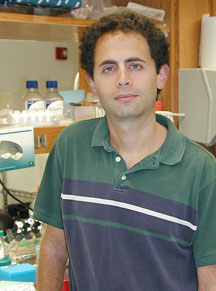

Detecting Breast Cancer Proteins Through Chemical and Analytical Proteomics
By Jason Socrates Bardi
Scripps Research Institute Professor Benjamin Cravatt reported the latest results of a cutting-edge "proteomics" method at the 230th national meeting of the American Chemical Society in Washington, D.C.
Cravatt and his colleagues looked at dozens of samples of human tumors from breast cancer patients, and then analyzed them with proteomics, the study of the expression, location, concentration, and activity of specific proteins. The scientists were able to detect human proteins that may be associated with breast cancer—including some that have never before been associated with the disease.
Proteomics has become an important tool in biology in the last decade because it offers the possibility of identifying proteins associated with specific diseases. These proteins can then potentially be used as markers for detection or prevention or as targets for the design of new drugs to treat the disease.
Cravatt, a professor in the Department of Cell Biology and The Skaggs Institute for Chemical Biology at Scripps Research, has been developing an emerging proteomics technology called activity-based protein profiling. Activity-based protein profiling is a broad method for identifying which proteins are active in a given biological sample by subjecting these samples to chemical probes called "affinity labels," which have the ability to attach to the active sites of entire enzyme families in complex proteomes. Then the active proteins can be pulled out with the affinity probes and identified.
The main drawback to the method has been that it lacks the sensitivity of some other approaches. But recently Cravatt combined his activity-based profiling with a highly sensitive proteomics method called multidimensional protein identification technology, or "MudPIT," which relies on mass spectrometry and was originally developed by the laboratory of Scripps Research Professor John Yates, with whom the Cravatt group collaborates. Basically, the two methods are applied in series—with the activity-based profiling returning pools of proteins and MudPIT then used to analyze these pools of protein in more detail.
"Using these two methods together," says Cravatt, "we have found some known and novel markers of breast cancer pathogenesis." The combined method, he adds, could potentially be applied to other human diseases to discover new markers currently evading detection by other methods.
Send comments to: jasonb@scripps.edu

Professor Benjamin Cravatt presented methods and findings at an American Chemical Society symposium. Photo by Kevin Fung.
